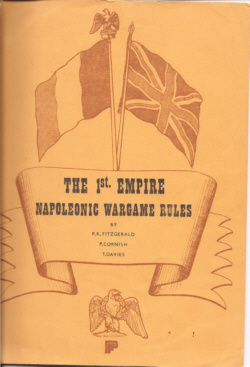|
|
|||||||||||||||||||||||||||||
 |
|
The Rules Directory only works if you help. Write a review. Get the review template here. |
|
TITLE: The 1st Empire: Napoleonic Wargame Rules, 2nd Edition AUTHOR: P. K. Fitzgerald, P. Cornish, T. Davies PUBLISHER: P. K. Fitzgerald PUBLICATION DATE: 1978 WEB SITE/SUPPORT FORUM: None PRICE (with date): Not Applicable REVIEWED BY: Mark “Extra Crispy” Severin PERIOD COVERED: The Napoleonic Wars THE BOOK: The 1st Empire is a 28 page comb bound booklet. It features card stock covers and interior pages that were typed and photocopied. The interior is two color, with diagrams in black and brown. There is a piece of errata hand-glued to one page. The back cover is also the QRS containing all the charts needed to play the game. SCOPE: 1st Empire is a tactical game of combat during the Napoleonic Wars. ARMY SIZE: 1st Empire armies will be of moderate size - most units are 15 or 16 figures. BASE UNIT: Units are infantry and cavalry battalions and artillery batteries. GAME SCALES:
BASING SIZES: All figures should be mounted individually, and units placed on movement trays. Infantry bases are 15 mm square. Cavalry bases are 20 x 40 mm and guns are 15 mm of frontage per gun in the battery. TURN SEQUENCE: Prior to the start of the game each player rolls a die to determine which side will move first. Thereafter player alternate turns as follows:
GAME MECHANICS: Game Dice: The game uses all six-sided dice, with special markings. You will need two normal dice. You will need four Average Dice (marked 2, 3, 3, 4, 4, 5). You will need three Shell Dice (marked 0, 0, 1, 1, 3, 7). You will need two Melee Deice (marked 2, 3, 4, 5, 6, 7). Movement: 1st Empire’s movement rules are as basic as they come. Rule 14 lists movement rates for troops types. Rule 15 lists costs to change formation (ranging from 1/4 move to a full move). Rule 16 is a terrain effects chart. There are no specific rules for wheeling, passage of lines, oblique etc. Morale: 1st Empire assigns Unit Type Factors to each unit. These factors range from +3 (Old Guard) to -3 (1813 Landwehr, Militia). The Type factor acts as a DRm to almost all rolls a unit may make during the game including, fire, melee and morale. To make a morale check a unit rolls an Average Die, modified by the Unit Type Factor and a list of modifiers. If the result is greater than 0, the unit is in good morale. These modifiers include having cover, a nearby general, being flanked, casualties, etc. If the result is less than 0 the unit may be shaken (may not advance but will stand), retire (half move back) or retreat (rout!). Reaction Tests: When units find themselves under threat from enemy cavalry, they must make a Reaction Test. The player rolls a die, modified for Unit Type Factor, attached generals etc. Then depending on the result, the unit will react. So an infantry ordered into square will, on a 6 or more, do so. On a 4 it will retain its original formation and on a 1 it will become unformed. The Reaction Charts take into account the units type, orders and situation. Fire Combat: Ranged fire includes both infantry and artillery. To resolve fire, each unit rolls between 1 and 3 Average Dice (artillery may roll Shell Dice in some cases), depending on type, nationality, etc. To this is added the Unit type Factor. If first volley or point blank range, the result is doubled. This is the Kill Factor. Cross referencing the Kill Factor with the number of firing figures on the chart results in a number. This number may be modified by the Fire Effect Chart. For example, if the target is cavalry the result is halved; if the target is in hard cover it is quartered, etc. Once the final result is determined, a casualty is inflicted for every 10 points scored. A unit “carries forward” any excess points. For example if you score 47 on an enemy unit, it must remove 4 figures and “carry forward” the remaining 7 points. Melee: Melee is resolved in essentially the same manner as fire. But the Kill factor is the Unit Type Factor x 2, plus the sum of two Melee Dice (see above), and adding the roll of any Impetus (average) dice for charging. The Kill Factor is again cross referenced and the result modified. Unformed units score half points against the enemy, flank attacks result in a x3 multiplier etc. Again for every 10 points a casualty is inflicted, and any excess points “carry forward.” The player causing more casualties is the winner. Losers make a morale check and winners make a control check. ARMY LISTS/SCENARIOS: There are no army lists or scenarios included, but the rules do include a few paragraphs describing how armies of the time were organized, as well as a bibliography of suggested further reading. REVIEWER’S COMMENTS: None. PLAYER’S COMMENTS: Not played. |
|
[Home] [15mm World] [Reviews Home] [How To] [Beginners Guide] [Gamer's World] [Spanner & The Yank] [Points of View] [The Annex] [Links] [Say Howdy] [Corporate Schill] [Rules Directory] |
 |
